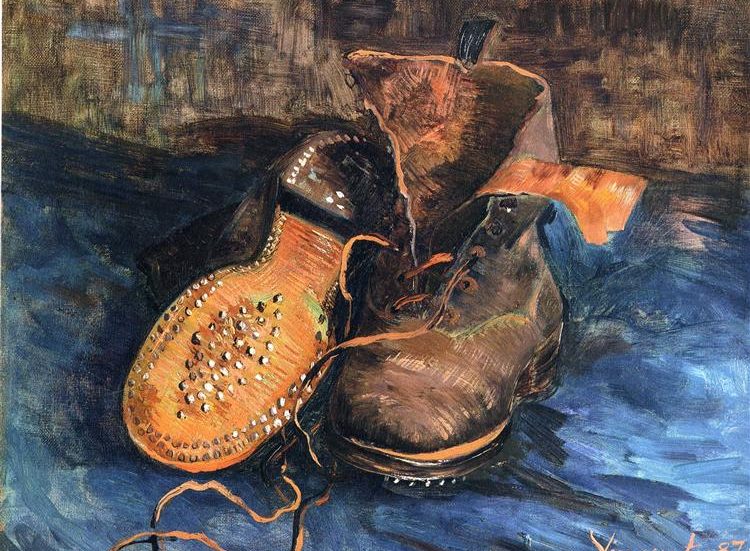Elizabeth Glass Turner ~ The Many Ways We Limp

The bottoms of your shoes tell a tale.
Examine them: the soles are worn down on the inside or the outside, at the front or at the back. They show how you walk. They show what you compensate for. They show the way your foot moves as you stride. And as you wear them, the sole of your shoe begins to tell the tale – of a back injury, of a sore hip, of a tender place on your foot.
A used pair of shoes will tell a foot doctor all about you.
**********
Yesterday I visited a massage therapist. I’d had deep tissue massages in the past. This one was slightly different: she had experience working on professional athletes. I told her a bit about what my body has been through the past couple of years. After briefly expressing this verbally to her, she responded, “let’s see what we find.”
Words weren’t needed. I didn’t need to tell her about my daily habits: my body told her. At one point I chuckled as her strong hands felt a sore spot and ruthlessly applied laser-like pressure to an area that felt only a few centimeters across on my shoulder.
“Muscles and joints can’t hide anything, can they? They don’t lie.”
She chuckled back.
“No, they don’t.”
My body told her I sit hunched with terrible posture at a laptop for hours at a time, writing and editing, oblivious to everything around me. It told her I’ve been hunched nursing a lot the past few months. It told her I go from 0 to 160, sitting a lot and then doing high impact activity like pushmowing the large, bumpy, uneven lawn for stress relief, flipping the mower over to clean out the bottom and continuing on my march. It told her I delivered a baby a few months ago and my joints are still coming back together.
I didn’t have to tell her once, “there! Right there. That’s the spot on my back.” Her hands felt and prodded, smoothed and bore down without my saying a word.
**********
So many of us have been mangling the bottom of our shoes trying not to show our limp. The body remembers old injuries, prone to re-injury. It also remembers the ways our muscles have attempted to compensate: a knee injury or hip injury on one side can lead to added pressure on the other side, throwing the other, completely uninjured side out of whack.
“Come to me, all of you who are weary and carry heavy burdens, and I will give you rest.”
So often Jesus looked at someone, and like a foot doctor examining the bottom of a pair of shoes, like a massage therapist honing in on the source of the knot, he saw the hidden limp; the old injury; the compensating stride; the posture attempting to correct itself. He asked questions, but not really because he needed to be told; rather, because people needed to tell.
**********
The body carries memories of trauma. Brains shriek with confusion when deep chemical pathways light up again. The moment of injury seems present, whether it was a car crash or personal violation, whether it was an injustice or words that ring years after the voice spoke them.
We can’t control or compensate for it a second longer: the limp returns. The muscle seizes. Some limps remain the rest of our lives. Others fade with time. Some need emergency surgery; others need quiet, careful, long-term care.
Today, can you bring your shoes to Jesus? Can you flip them over and examine the soles? What would a specialist say about how you walk? What would a sports massage therapist know about how you spend your hours? Jesus can see you limping, or fighting to hide it. Can you give him your shoes?
Can you say, “here. I’ve been hiding this injury, or trying to hide it, for so long. It’s thrown off the whole way I walk. I’ve become so used to the ache I don’t even notice it unless I sit very still and quietly. And then I feel it crying out for relief. But that pain is so hard to sit with, it is overwhelming. I can’t do it by myself without help, I might vomit from the pain.”
You don’t have to tell him the hard words unbearable to speak aloud. Just give him your shoes. They’ll tell the story.
It is okay to stop running.
Who has believed our message and to whom has the arm of the Lord been revealed? He was despised and rejected by mankind, a man of suffering, and familiar with pain. Surely he took up our pain and bore our suffering, yet we considered him punished by God, stricken by him, and afflicted. But he was pierced for our transgressions, he was crushed for our iniquities; the punishment that brought us peace was on him, and by his wounds we are healed. – Isaiah 53:1, 3a, 4-5